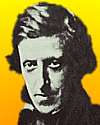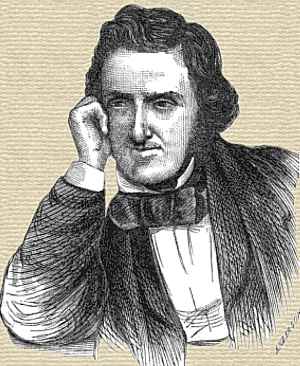 (source)
(source)
|
Frederick Scott Archer
(1813 - 2 May 1857)
English inventor who invented the photographic wet collodion process (1850), the first by which multiple prints could be made, and used for the next three decades until replaced by the use of the modern gelatin emulsion. He also invented ambrotype portrait process by a positive photographic image is produced on sheet of glass using the wet plate collodion process.
|
Life of Frederick Scott-Archer
from A History of Photography (1888)
[p.39] Although Le Gray and Bingham may take the credit for having been the first to suggest a possible use of collodion in photography, yet the merit of the invention and publication of the collodion process proper belongs entirely to Frederick Scott-Archer; his article describing this method first appearing in a London periodical called The Chemist, in March, 1851.
Born at Bishop Stortford, in 1813, Archer was apprenticed to a silversmith in Leadenhall Street, London. His tastes were artistic, and on attaining manhood he became a sculptor. It is said that his early attempts at photography, by the calotype method, about 1847, were stimulated by his desire to employ the art to secure mementos of the productions of his chisel. In September, 1850, Archer’s new process was so far advanced that he communicated it to his friends, among whom were Dr. H. W. Diamond, Mr. P. W. Fry, and others, from whom he received much assistance. Probably Archer did not realize the importance of his discovery, for he did not attempt to patent it; although in 1855 he patented a method of removing the collodion film from glass by coating it with gutta-percha, an improvement which had little or no practical value.
So good and complete was Archer’s method that in three or four years it practically displaced both calotype and daguerreotype, and reigned supreme from 1855 to 1880. The inventor took up photography professionally, opening a studio in Great Russell Street, near the British Museum; but he made no money by photography, for his brain was too busy in imagining new things to reap the benefit of that which he had already accomplished. Among other inventions devised by Archer, [p.40] we may name a camera, within which the plates could be developed and fixed, as well as exposed; a triplet lens; and a useful method of whitening positives on glass by soaking them in mercury bichloride. This was called the “alabastrine process.”
Scott-Archer died in May, 1857, and was buried in the London suburban cemetery called Kensal Green. A subscription of £747 was raised for his widow and little children; but, Mrs. Archer dying shortly afterwards, the amount was settled on the children, together with a government pension of £50 per annum, awarded on the ground that their father was “the discoverer of a scientific process of great value to the nation, from which the inventor had reaped little or no benefit.”
The following account is taken from a small book—“Manual of the Collodion Photographic Process”—published by Archer in l852; a second edition appeared in 1854.
1. Immerse eighty grains of cotton-wool in a mixture of one ounce each of nitric and sulphuric acids; take out after fifteen seconds, and wash thoroughly in running water.
2. Dissolve the pyroxyline so obtained in a mixture of equal parts of sulphuric ether and absolute alcohol. The solution so obtained is ordinary collodion.
3. Add some soluble iodide—usually iodide of potassium—to the collodion. A little potassium bromide may also be added.
4. Pour the iodized collodion on a perfectly clean glass plate, and allow two or three minutes for the film to set.
5. Take the coated plate into the dark-room and immerse it in a bath of silver nitrate (30 grains to every ounce of water) for about a minute. Here a chemical change takes place by which silver iodide is formed in the pores of the collodion.
6. Remove the plate, which is now sensitive to white light, place it in a slide-holder, and expose it in the camera. The time of exposure “may vary from one moment to a quarter of an hour.”
7. Take the plate back to the dark-room and develop it by pouring on it a mixture of water, one ounce; acetic acid, one dram; pyrogallic acid, three grains. Archer claims that “the [p.41] great power shown by pyrogallic acid in bringing out the latent image was first made known by me in a short description in the May number of The Chemist for 1850.”
8. Fix the image by soaking the plate “in a strong solution of hyposulphite of soda.” At a later period cyanide of potassium was preferred by most operators for this purpose.
When a single picture only was desired, a short exposure was given, and the deposit of metallic silver which forms the image was whitened by soaking the developed plate in mercury bichloride. When a black surface was then placed behind the photograph it stood out on the glass in correct black and white as a positive image. Probably every household has specimens of such collodion positives, of which large numbers were produced between 1854 and 1870. An American improvement consisted in the use of thin plates of black or chocolate enamelled iron—ferrotypes, irreverently called tintypes—or sheets of black japanned leather, instead of glass. Itinerant photographers still employ this “positive” method largely, since by it they can complete and hand over their productions to their clients within a few minutes.
For making lantern slides the wet collodion process is still considered one of the best, if not the best method.
Up to about 1853 a photograph was considered a curiosity; but the introduction and perfection of the collodion process made popularization of photography, for the first time, a really popular Photography. pursuit. With mistaken ideas as to the ease of the new method, large numbers of amateurs purchased the necessary materials; and, about 1858, the camera became as common an object as the barrel organ!
- 2 May - short biography, births, deaths and events on date of Archer's death.
- Photography: Essays & Images; Illustrated Readings in the History of Photography, by Beaumont Newhall (ed.). - book suggestion.





